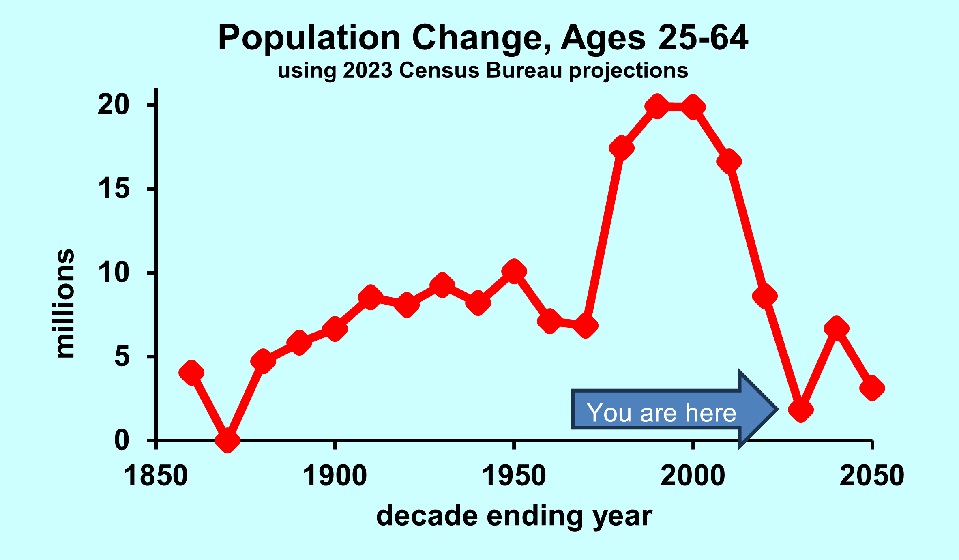Image caption: Change in working age population each census. DR. BILL CONERLY BASED ON CENSUS BUREAU DATA
Read the original article on Forbes.com
The U.S. Census Bureau issued new long-term population projections which are gloomy for employers. The growth of the working age population in the current decade, from 2020 to 2030, will be the lowest since the Civil War. These projections indicate even less labor force growth than the previous figures, which were released in 2018. Lower immigration than previously expected dominates the labor force issue. The Census Bureau believes immigration in future years will be about 17% lower than they previously projected—which itself was lower than 2014 projections.
Hiring and retaining workers will be a dog-eat-dog, employer-eat-employer effort. The ability to succeed in this competition will differentiate successful companies from laggards. The keys to business success in this environment are employee productivity, retention and recruiting—in that order.
Attitudes About Employment
Before specific strategy steps are considered, business leaders should examine how their own attitudes align with the challenge. In the chart above, notice the four decades of high growth in the working-age population. Those are years from 1970 through 2010. The baby boomers were coming of age, and then their children came of age. The chart does not show the other huge change: women in the workforce. In 1970, there were 32 million women in the workforce (either working or actively looking for work). By 2010, the number was 72 million.
That abundance of people available to work led managers to treat workers as disposable. If one didn’t work out, there were plenty of other applicants available. That’s obviously an overstatement, but it’s certainly true that development of skills and retention of talent took a lower priority because of the many people looking for work. Business leaders now must develop an attitude that labor is scarce and to be nurtured and treasured—not for charitable reasons, but to get the job done.
Worker Productivity
Productivity of workers is the most important element in business strategy for the tight labor market. Productivity does not usually mean exhortations or threats or pep talks. Rather, training, tools and management should dominate productivity efforts.
Training usually begins at the beginning, but continued training will help experienced workers be even more productive. People cannot absorb everything all at once, so staggered and continuous training helps employees achieve their potential.
Tools are vital in virtually every job, whether the tools are screwdrivers, software or trucks. A focus on how the tool helps productivity ensures that capital spending is not just for shiny toys, and not for excessive complexity, but getting more work accomplished by a given worker.
Good management helps productivity by putting the right person on the right job at the right time. Good managers know their workers well, including their strengths and weaknesses. They can coach weak workers, but more importantly they can nurture moderately good workers and motivate excellent workers to do even more.
Employee Retention
Retaining good and even average employees boosts overall output and lowers costs. The old saying that “people don’t quit companies, they quit bosses,” is true. Better training of first-level supervisors helps employee retention more than fancy fringe benefits. Stay Interviews—once managers are trained in the process—help retention.
Compensation, both salary and fringe benefits, must be competitive, but need not be higher than market. Too many managers accepts a departing employee’s explanation that he found 50 cents an hour more at another company. The manager must ask herself, why did this worker go looking for a 50 cent pay raise? Most likely, better managerial skills could have kept the worker.
Retention is much easier when the right people are hired in the first place. Sometimes managers get desperate, especially when a valuable employee has just left. Desperate hires, though, seldom work out. Each job requires specific skills from the employee, but more importantly certain attitudes and personalities. Finding the person who will embrace the company culture and values usually works much better than the wrong personality who seems to have the right skills.
Employee Recruiting
Even with good productivity and retention, new hires will be needed. Hiring is easier when employee retention is good. Satisfied employees are more likely to recommend their companies to friends and acquaintances. So the retention steps outlined above are the first steps to better recruiting.
In decades past, many businesses simply waited until someone walked in the door, or they put a “Help Wanted” sign outside their shop, or advertised in the newspaper. In today’s tight labor market, recruiting requires a marketing strategy. How can a company attract the people who will find working at the company satisfying? In the coming years, marketing to prospective employees will be nearly as important as marketing to prospective customers.
This new world of tight labor availability is not about the pandemic. Consider the conclusion that this decade is having the lowest growth of the population since the Civil War. That showed up in the 2018 projections, just not as prominently as in today’s projections. Employers have a long slog ahead of them, which won’t be much easier for many years.

0 Comments